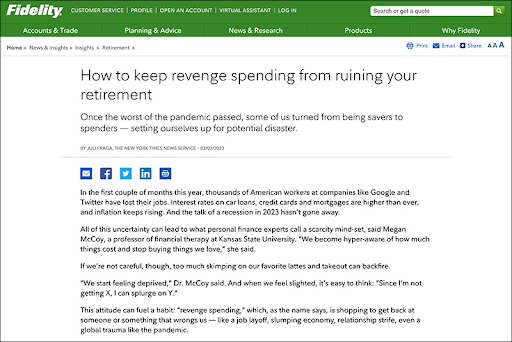
Content marketing involves the creation and publication of online material in an effort to boost brand visibility and awareness. This material can come in many forms, including blog posts, white papers, e-books, infographics, videos and podcasts — everything and anything that can be consumed by potential and returning customers. Creating rich and exciting content not only informs consumers about who you are, it’s also essential for engaging prospects and driving conversions.
Content marketing is so successful that 70% of marketers are actively investing in it, with 77% saying they have a comprehensive content marketing strategy. Content marketing is powerful and potent. Here’s why.
How Does Content Marketing Work?
Content marketing works to boost your brand in many ways. It serves as a tool to lead prospects down the funnel. Assets should work together to raise awareness, nurture leads, and eventually lead to conversions. Each piece of content will have a different goal, depending on which stage the prospect is in.
Why Does Content Marketing Matter?
The goal of content marketing is to create and distribute relevant content for your target audience. A strong content marketing strategy can help build brand awareness and position you as a leader in the industry. Successful content marketing can become a passive way to generate leads. Lastly, content marketing is an economical marketing strategy, generating over three times as many leads as outbound marketing and costing 62% less (Demand Metric). Learn more about how to drive long-term results through content marketing.
Why Does Storytelling Matter in Content Marketing?
Storytelling is essential throughout the customer journey, as humans are programmed for stories. Our brains respond better to information when presented in a story, which works exceptionally well for brands trying to capture their audience. By focusing on storytelling, brands can ensure their marketing material is memorable.
Content Marketing Examples
Content marketing comes in many shapes and forms. Whether it’s in the form of a newsletter, social media post, case study, podcast, infographic, video, blog article, or website landing page, content marketing is a core tactic for brand building. Below are some examples of successful content marketing programs.
AdvisorStream Licenses Content to Build Relationships
AdvisorStream recognized the opportunity to enhance its financial content marketing efforts by incorporating top-notch content through licensed, reliable articles from NYTLicensing.
Fidelity Uses Licensed News Stories to Keep Customers Informed
Fidelity Investments effectively keeps its customers informed through the strategic use of licensed news stories in their financial content marketing.

Does Content Marketing Actually Work?
The short answer is yes: content marketing can be highly effective when executed strategically. In fact, 82% of consumers feel more positive about a company after reading custom content. Content marketing helps educate potential customers, engage current customers, and guide leads through the buying journey. Below, find reasons why content marketing works.
There are several reasons why a content marketing solution can help to achieve your organization’s goals.
5 Reasons Why Content Marketing Works
1. Brand Awareness
Producing informative content that showcases your company’s expertise and provides information about your products will help you drive awareness about your brand. Brand awareness is essential for a variety of reasons; one of the most important is simply that consumers tend to purchase products from companies they know and trust.
Think of it this way: No matter how small or niche your industry is, you’re still likely to have many competitors. So how do you stand out and inspire consumers to click on your website? By creating quality content to showcase what your brand represents.
But this doesn’t just mean showcasing your products and services. You also have to show off your values. Content marketing can help consumers understand the qualities that make your brand stand out, especially when utilizing empathetic marketing or authenticity in your marketing campaign.
2. Thought Leadership
Utilizing thought leadership content can help you establish credibility with your audience. In a world full of digital noise and short attention spans, creating compelling, essential content is the best way to build recognition as a thought leader while moving consumers down the sales funnel.
Not sure how to create thought leadership content that converts? Ask subject matter experts in your company to develop content, or if you have time or resource constraints, consider licensing content from outside sources. Working with NYTLicensing can help you harness the power of world-class journalism to provide your consumers with industry-specific material.
3. Generating Leads
On top of telling your brand’s story, content marketing is an excellent way to generate leads and to spark your audience’s interest in your products and services. That’s because content marketing doesn’t just promote your products; it also shows consumers how, when and where to use them. This supplemental information is essential when it comes to standing out from the digital noise. Your job is to solve problems for consumers. Therefore, your content marketing should clearly present to consumers how you can assist them, while gently nudging them toward becoming sales leads.
Other digital and content marketing best practices can also promote lead generation. For example, long-tail blog posts with links to various product pages on your site can help users move through your website, which in turn will help you generate leads.
4. Lead Nurturing
No consumer is the same, so you’ll have to work hard as a brand to nurture every customer that engages with your website. Content can help you do that, as it compels readers to learn more, even if they’re returning customers. In addition, developing unique content campaigns that explore different content formats like infographics and videos can keep customers engaged and interested as they move through the sales cycle and marketing funnel.
5. Closing Sales
When it finally comes time to inspire a consumer to convert, let content be king. Ensuring the content you provide your audience contains key facts and selling points about your products will help move your leads toward a final decision. Often, something as simple as a blog post with customer testimonials can convince users to book a product demo, sign up for a phone call or make a final purchase decision.
How to Start Driving Results With Content Marketing
Now that you know how content marketing can help your brand, it’s time to strategize! Here are some tactics you can use to drive results with your content marketing efforts.
Determine Who Your Audience Is
This is the first thing you should do before even putting pen to paper or keyboard to Google Doc. You won’t be able to create valuable content without truly knowing who your customers are, including what they’re looking for, their desires and their pain points. To get a feel for your audience, start by creating buyer personas, i.e., descriptions of your organization’s ideal buyers. You can then use this information to guide your marketing strategy. Be sure to incorporate insights from sales, business development, marketing, and product into these personas.
Focus on Industry-Related Topics
Above all, it’s vital that the content you share is exciting and informative for your target audience. But you must be smart about what you post. While it can be valuable to touch on trending topics and news, if your content isn’t explicitly geared toward your industry, it won’t drive the kind of beneficial traffic that turns into leads.
Consider curating news from trusted sources and publications. Financial news, healthcare trends, and business news can be great components to include in your strategy, depending on your industry. Being able to showcase industry specific news content and insights from thought leaders can build credibility and trust with consumers.
Share Your Content in Different Ways
You can never have too many types of content, so feel free to play around with different formats. For example, while it’s common knowledge that a blog content strategy can be very successful, infographics, videos and social media posts can also have significant audience appeal. You can also experiment with curated newsletters showcasing industry news or different kinds of content syndication campaigns. By promoting these different content channels, you’ll encourage others to share, which will drive more traffic to your website. It’s the best of both worlds!
Create a Content Strategy
The most successful content marketers have a strategy in place. Once you've determined how you will develop content and the formats, your team should create an editorial calendar. This strategy should be tied to content marketing KPIs and overarching business goals.
For departments that produce a lot of content, it may also be beneficial to further break out this plan by persona or channel. For example, your team may elect to also create a more comprehensive blog content strategy, global content strategy, or a social media plan.
Supplement Your Editorial Calendar With Licensed Content
Licensed content is a fantastic way to bring fresh voices and perspectives to your regularly scheduled content. Using licensed editorial content will save you time and effort, because you won’t have to produce the content yourself. It will also dramatically boost your credibility with your target audience. By associating your brand with renowned publications like The New York Times and The Economist, you can propel your business and your content forward.
How to Show the Value of Content Marketing
In order to show the value of content marketing to stakeholders or non-marketing colleagues, it’s important to use specific metrics such as conversions, traffic data, form completions, or another specific KPI (key performance indicator). You can use various formats to present the results, such as powerpoints, infographics, or videos. Ultimately, the value of content marketing is measured by a customer or lead’s engagement with your brand.
Final Thoughts
Content marketing works. There’s a reason the phrase “content is king” is so famous — it’s true! When an organization creates content, it not only boosts its brand awareness, it answer its readers’ questions before they even get a chance to ask them. These efforts in turn increase lead generation, increased engagement on your blog, and ultimately, sales.
Utilize NYTLicensing for an easier way to incorporate content. With the many different copyright licensing solutions we offer, you’re sure to find content that can help you achieve your digital content marketing goals.
Frequently Asked Questions:
How effective is a content marketing strategy?
The effectiveness of a content marketing strategy can vary based on factors such as the quality of content, the consistency, the target audience, and the distribution channels. When executed correctly, content marketing can be highly effective in building brand awareness, driving engagement, and establishing authority.
Why is content marketing effective?
Content marketing is effective because it’s a sustainable and cost-effective marketing strategy that builds trust with your audience, nurtures them, and answers their questions. When implemented correctly, content marketing helps businesses generate leads, increase conversions, and ultimately lead to more sales through guiding prospects, leads, and customers through the funnel.
Is content marketing better than traditional advertising?
Content marketing is a long term, SEO-driven marketing tactic that can help nurture visitors and prospects into lifelong customers. And the numbers prove its worth: content marketing generates great leads and costs nearly 62% less than traditional marketing channels while bringing in three times as many leads.
What are the best content marketing strategies?
The best content marketing strategies are personalized and tailored to your unique business goals and target audience. The best strategies generally start by understanding the target audience, then creating consistent and high-quality content. The best content marketing strategies leverage various content formats to reach a wider audience.


